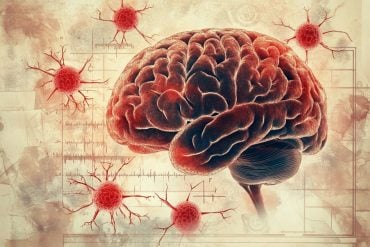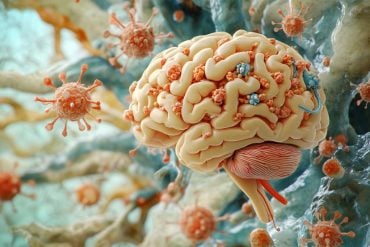Summary: Researchers link the inflammation associated with chronic sinus infections to alterations in brain activity in networks that govern cognition, external stimuli, and introspection. The findings shed light on why people suffering from sinus infections often report poor concentration and other short-term cognitive problems.
Source: University of Washington
The millions of people who have chronic sinusitis deal not only with stuffy noses and headaches, they also commonly struggle to focus, and experience depression and other symptoms that implicate the brain’s involvement in their illness.
New research links sinus inflammation with alterations in brain activity, specifically with the neural networks that modulate cognition, introspection and response to external stimuli.
The paper was published today in JAMA Otolaryngology-Head & Neck Surgery.
“This is the first study that links chronic sinus inflammation with a neurobiological change,” said lead author Dr. Aria Jafari, a surgeon and assistant professor of Otolaryngology-Head & Neck Surgery at the University of Washington School of Medicine.
“We know from previous studies that patients who have sinusitis often decide to seek medical care not because they have a runny nose and sinus pressure, but because the disease is affecting how they interact with the world: They can’t be productive, thinking is difficult, sleep is lousy. It broadly impacts their quality of life. Now we have a prospective mechanism for what we observe clinically.”
Chronic rhinosinusitis affects about 11% of U.S. adults, according to the Centers for Disease Control and Prevention. The condition can necessitate treatment over a span of years, typically involving antibiotics. Repeated cycles of inflammation and repair thicken sinus tissues, much like calloused skin. Surgery may resolve the issue, but symptoms also can recur.
The researchers identified a study cohort from the Human Connectome Project, an open-access, brain-focused dataset of 1,206 healthy adults ages 22-35. Data included radiology image scans and cognitive/behavioral measurements.
The scans enabled them to identify 22 people with moderate or severe sinus inflammation as well as an age- and gender-matched control group of 22 with no sinus inflammation. Functional MRI (fMRI) scans, which detect cerebral blood flow and neuronal activity, showed these distinguishing features in the study subjects:
- decreased functional connectivity in the frontoparietal network, a regional hub for executive function, maintaining attention and problem-solving;
- increased functional connectivity to two nodes in the default-mode network, which influences self-reference and is active during wakeful rest and mind-wandering;
- decreased functional connectivity in the salience network, which is involved in detecting and integrating external stimuli, communication and social behavior.
The magnitude of brain-activity differences seen in the study group paralleled the severity of sinus inflammation among the subjects, Jafari said.
Despite the brain-activity changes, however, no significant deficit was seen in the behavioral and cognitive testing of study-group participants, said Dr. Kristina Simonyan, a study co-author. She is an associate professor of otolaryngology-head & neck surgery at Harvard Medical School and director of laryngology research at Massachusetts Eye and Ear.
“The participants with moderate and severe sinus inflammation were young individuals who did not show clinically significant signs of cognitive impairment. However, their brain scans told us a different story: The subjective feelings of attention decline, difficulties to focus or sleep disturbances that a person with sinus inflammation experiences might be associated with subtle changes in how brain regions controlling these functions communicate with one another,” said Simonyan.

It is plausible, she added, that these changes may cause more clinically meaningful symptoms if chronic sinusitis is left untreated. “It is also possible that we might have detected the early markers of a cognitive decline where sinus inflammation acts as a predisposing trigger or predictive factor,” Simonyan said.
Jafari sees the study findings as a launch pad to explore new therapies for the disease.
“The next step would be to study people who have been clinically diagnosed with chronic sinusitis. It might involve scanning patients’ brains, then providing typical treatment for sinus disease with medication or surgery, and then scanning again afterward to see if their brain activity had changed. Or we could look for inflammatory molecules or markers in patients’ bloodstreams.”
In the bigger picture, he said, the study may help ear-nose-throat specialists be mindful of the less-evident distress that many patients experience with chronic sinusitis.
“Our care should not be limited to relieving the most overt physical symptoms, but the whole burden of patients’ disease.”
Funding: Study funding was provided by the National Institute on Deafness and Other Communication Disorders (R01DC011805), part of the National Institutes of Health (NIH). Data were provided in part by the Human Connectome Project, which is funded by 16 NIH institutes and centers (1U54MH091657).
About this neurology research news
Source: University of Washington
Contact: Brian Donohue – University of Washington
Image: The image is in the public domain
Original Research: Open access.
“Association of Sinonasal Inflammation With Functional Brain Connectivity” by Jafari et al. JAMA Otolaryngology-Head & Neck Surgery
Abstract
Association of Sinonasal Inflammation With Functional Brain Connectivity
Importance In recent years, there have been several meaningful advances in the understanding of the cognitive effects of chronic rhinosinusitis. However, an investigation exploring the potential link between the underlying inflammatory disease and higher-order neural processing has not yet been performed.
Objective To describe the association of sinonasal inflammation with functional brain connectivity (Fc), which may underlie chronic rhinosinusitis–related cognitive changes.
Design, Setting, and Participants This is a case-control study using the Human Connectome Project (Washington University–University of Minnesota Consortium of the Human Connectome Project 1200 release), an open-access and publicly available data set that includes demographic, imaging, and behavioral data for 1206 healthy adults aged 22 to 35 years. Twenty-two participants demonstrated sinonasal inflammation (Lund-Mackay score [LMS] ≥ 10) and were compared with age-matched and sex-matched healthy controls (LMS = 0). These participants were further stratified into moderate (LMS < 14, n = 13) and severe (LMS ≥ 14, n = 9) inflammation groups. Participants were screened and excluded if they had a history of psychiatric disorder and/or neurological or genetic diseases. Participants with diabetes or cardiovascular disease were also excluded, as these conditions may affect neuroimaging quality. The data were accessed between October 2019 and August 2020. Data analysis was performed between May 2020 and August 2020.
Main Outcomes and Measures The primary outcome was the difference in resting state Fc within and between the default mode, frontoparietal, salience, and dorsal attention brain networks. Secondary outcomes included assessments of cognitive function using the National Institutes of Health Toolbox Cognition Battery.
Results A total of 22 patients with chronic rhinosinusitis and 22 healthy controls (2 [5%] were aged 22-25 years, 26 [59%] were aged 26-30 years, and 16 [36%] were aged 31-35 years; 30 [68%] were men) were included in the analysis. Participants with sinonasal inflammation showed decreased Fc within the frontoparietal network, in a region involving bilateral frontal medial cortices. This region demonstrated increased Fc to 2 nodes within the default-mode network and decreased Fc to 1 node within the salience network. The magnitude of these differences increased with inflammation severity (dose dependent). There were no significant associations seen on cognitive testing.
Conclusions and Relevance In this case-control study, participants with sinonasal inflammation showed decreased brain connectivity within a major functional hub with a central role in modulating cognition. This region also shows increased connectivity to areas that are activated during introspective and self-referential processing and decreased connectivity to areas involved in detection and response to stimuli. Future prospective studies are warranted to determine the applicability of these findings to a clinical chronic rhinosinusitis population.







